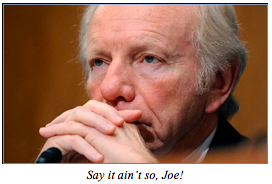Senator Joe Lieberman should be ashamed of himself.
He said he would not support a “public option.” But he did. He knows he did—and he’s hoping the American people don’t.
Of course, to listen to the press coverage of Senate Majority Leader Harry Reid’s manager amendment, one would think that taxpayer-subsidized, government-run health care was no longer a part of the proposal.
For example, reports TalkingPointsMemo.com, “The public option is dead. Its successors are dead.” Oh, really.
Then, how is it that, so conspicuously in the Congressional Budget Office’s (CBO) cost estimate, there lays some $871 billion in taxpayer subsidies from insurance coverage provisions?
Is this some kind of sick joke? Do Harry Reid and Barack Obama really think they can spend a trillion dollars over ten years on government-run health care—and then convince taxpayers that they are not doing so, simply by rhetorical tomfoolery and sleight of hand?
Does it really matter if the taxpayer subsidies are funneled through insurance “exchanges” rather than monolithic bureaucracies? Did the public-private model serve Fannie Mae and Freddie Mac any better when they finally went bankrupt last year in the midst of the financial crisis?
The answers to these questions are obvious enough. Whether through single-payer, co-ops, insurance “exchanges” or the like, taxpayers are going to be on the hook for a trillion dollars.
As if the problem with the “public option” was a marketing difficulty to be surmounted by changing the name.
The numbers don’t lie, although they tend to be understated. For example, the CBO writes that the net cost “reflects a gross total of $871 billion in subsidies provided through the exchanges, increased net outlays for Medicaid and the Children’s Health Insurance Program (CHIP), and tax credits for small employers; [but] those costs are partly offset by $149 billion in revenues from the excise tax on high-premium insurance plans and $108 billion in net savings from other sources.”
And so, the CBO concludes, the cost of increasing subsidized health care is only $614 billion. How do they come to that conclusion? By including the $149 billion in revenues and $108 billion in “savings” in the same table labeled “net changes in the deficit from insurance coverage provisions.”
Which is simply duplicitous. To discover the hidden cost of the insurance provisions, one has to read the following footnote to that controversial table: “Includes excise tax on high-premium insurance plans.” Really, the excise tax should have been included in the table clearly labeled, “net changes in the deficit from other provisions affecting revenues.”
And, as a result, that table should have read that the bill increases taxes by $413 billion, not $264 billion.
The high jinks do not stop there, however. The estimate claims that the bill “would yield a net reduction in federal deficits of $132 billion over the 2010-2019 period.”
That is accurate, of course, only if one assumes the impossible that the $483 billion in proposed cuts to Medicare ever occur. By far the most unpopular provision has been the inevitable rationing of care away from seniors that would occur under the Congressional Democrat proposal.
Of course, the only purpose of the phony “cuts” is to obtain a better score from CBO. The “cuts” are restored in concurrent legislation called the “doc-fix”.
The result? The new “public option” will spend some $350 billion more than it takes in through revenues in its first ten years alone. And, the subsidized care provided through the exchanges will still create a state-run monopoly in the health insurance market, drive up premiums, muscle individuals out of their privately-provided care, deplete the public treasury, and once bankrupt, result in the rationing of medical treatment away from the American people, especially seniors.
All of the goals of the Democrat-sponsored plan—reducing costs, slashing the deficit, expanding coverage, etc.—all fail, raising the question: Why?
The only reason is that the stated goals are a ruse. And the real goal is ideological: to move America to a socialized single-payer health system that will cost trillions—one way or another.
Senator Joe Lieberman had but one chance to stop this madness in the final cloture vote early this morning. If he had meant what he said that he did not support a “public option,” surely he would have agreed that $871 billion in taxpayer subsidies for health insurance is quite public.
Instead, he voted along party lines in the monumental 60-40 vote.
Changing the name and funneling the taxpayer dough through “exchanges” will not hide the facts—or his shame.
Robert Romano is the ALG Senior News Editor.


